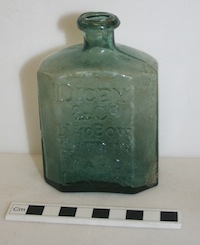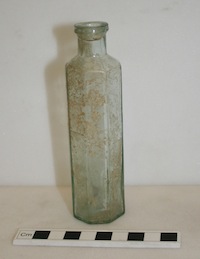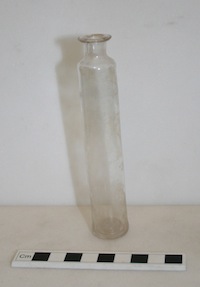- Stay Connected
 Abraham Lincoln
If given the truth, the people can be depended upon to meet any national crisis...
Abraham Lincoln
If given the truth, the people can be depended upon to meet any national crisis...
 Guildford news...
for Guildford people, brought to you by Guildford reporters - Guildford's own news service
Guildford news...
for Guildford people, brought to you by Guildford reporters - Guildford's own news service
Bottles Bricked Up For Nearly 200 Years
Published on: 28 Feb, 2012
Updated on: 28 Feb, 2012
Nick Booth, assistant collections officer with Guildford Borough Council’s Heritage Service, writes about four old bottles that were found in a bricked-up chimney at a house in St Catherine’s Village.
Earlier this year (2011) Guildford Museum received the offer of a donation of a collection of four bottles found in the St Catherine’s area of Guildford.
The donor’s husband and father had found them bricked up in a chimney in a property on St Catherine’s Hill in around 1968, and has kept them ever since.
The bottles were identified by Mary Alexander from the museum, before being added to its local history collection:
Bottle 1: – a large green bottle from the 18th century with candle stub in neck. It is handmade and has a seal attached to the side, which usually shows the owner’s initials or crest. In this case it is an anchor, which might be a personal crest, or might show that the bottle belonged to an inn called the Anchor.
At this date wine came in barrels and was decanted into the customer’s own bottles. The candle stub is of a more recent date (post 1968) and is a nice example of how found objects can be reused by their new owners.
Bottle 2: – This bottle originally contained Daffy’s Elixir, as it says on it. This was a patent medicine invented by a Mr Daffy in the mid 17th century. He died in 1680. The elixir was a mixture of herbs advertised mostly as a general tonic and became very famous.
It was in use until the late 19th century. This bottle probably dates to the late 18th century or the first half of the 19th century.
It has ‘True Daffy’s Elixir’ embossed on one side and ‘Dicey & Co. No.10 Bow Churchyard, London’ on the other. Dicey & Co were one of several companies who used the name ‘Daffy’s Elixir’.
It has been made in a mould which split diagonally across the bottle, which can be seen on the shoulder. It could have been bought at St Catherine’s fair.
Bottle 3: – This bottle was also made in a mould, although the lip has been finished off rather unevenly.
The bottle probably dates to the first half of the 19th century. It would have been used for various liquids sold in small quantities. The bottle has brown encrustations on the outside.
Bottle 4: – This bottle is of a 19th century date, and was used perhaps for perfume or cosmetics.
The property the bottles were found in dates from the 17th century, which means that they must have been bricked up in the fireplace at a later date than the buildings construction. It is interesting that the bottles do not all appear to date to the same period, with the large green bottle dating to the 18th while the others are slightly later. This suggests that the bottle were placed in the fireplace no earlier than the 19th century, and also that the larger green bottle was fairly old by this time as well.
Unfortunately, no evidence to suggest why the bottles were bricked up survives, however it is tempting to suggest that there was some type of ‘good magic’ at work.
It was an apparently widely followed custom to brick items such as bottle or items of clothing into buildings, especially close to entrance points such as doors, windows and chimneys.
The most famous examples of this are what’s known as “witches bottles”, which often contained urine or hair from the owner and sometimes pins or other sharp items. The idea was that a witch or demon would come into the property and attack the bottle, attracted by the urine or hair, become stuck and pricked by the pins.
In this way the intended victim would be safe, and the magical attacker would be foiled and perhaps even stopped altogether. This relates back to the Hidden House Histories Exhibition held by Guildford Museum a few years ago.
The bottles, which were some of the first to be catalogued using the museum’s new computerised database, have been accessioned into the museum collection and assigned the number LG.4601.
















Recent Comments